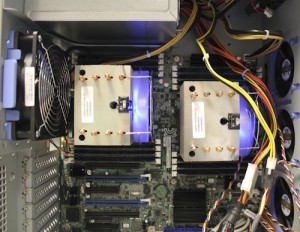TEST SETUP AND METHODOLOGY
 In testing the Intel SSD DC P3700, along with all enterprise drives, we focus on long term stability. In doing so, we stress products not only to their maximum rates, but also with workloads suited to enterprise environments.
In testing the Intel SSD DC P3700, along with all enterprise drives, we focus on long term stability. In doing so, we stress products not only to their maximum rates, but also with workloads suited to enterprise environments.
We use many off-the-shelf tests to determine performance, but we also have specialized tests to explore specific behaviors we encounter. With enterprise drives, you will see that we do not focus on many consumer level use-cases.
Our hope is that we present tangible results that provide relevant information to the buying public.
It should be noted that the P3700 was tested under Windows Server 2012 R2, as Windows 7 does not currently have native of vendor driver support for this device. All other drives listed in the comparison were tested with Windows 7.
LATENCY
To specifically measure latency, we use a series of 512b, 4K, and 8K measurements. At each block size, latency is measured for 100% read, 65% read/35% write, and 100% write/0% read mixes.
With many PCIe SSDs, queue depth can have a large impact on performance. Unlike SATA SSDs, that normally top out at a queue depth of 32, PCIe SSDs often don’t level out until queue depths of 128 and 256. For our latency testing, we made sure to look at queue depths of 32 and 256, just to get a gauge on how the P3700 would perform. In both cases, the P3700 performed really well. Both graphs look almost identical. What’s more impressive is the incredibly low latency on the 100% read tests.
Overall, maximum latency was also very low. Not the lowest we have ever seen, but those numbers are very consistent, even over tests that last for days.
ADVANCED WRITE TESTING
As we talked about in our Micron P400m SSD Review, SSDs have different performance states. Since the Intel SSD DC P3700 is an enterprise SSD, we will focus on steady state performance. With the following tests, we stressed the drive using random 4KB write workloads across the entire span for at least 24 hours. This is more than enough to achieve steady state. The following graph is showing the latency and IOPS across an 11 hour span.
Looking at the performance over time, the P3700 performs great. We always view the results at a high level and then zoom in on the data. With 93K write IOPS, the P3700 is a solid performer, especially for the 800GB model.
Even when we only look at the last hour of testing, we can see the tight distribution of IOPS. Normally, when we look at IOPS this high, we see more of a loose distribution, but the P3700 is able to maintain a really high level of performance with great consistency. You will see this in the next tests, but when we looked at write performance, the P3700 didn’t require crazy high queue depths. In fact, just a few outstanding IOs are enough to maximize the write performance. So, for write consistency, a queue depth of 32 was more than enough to get the results we were after. At 93K IOPS, the P3700 had no problems hitting the 90K maximum IOPS that it is rated for.
 The SSD Review The Worlds Dedicated SSD Education and Review Resource |
The SSD Review The Worlds Dedicated SSD Education and Review Resource | 

Since you say that you will test later on with consumer workloads,it would be nice to see an ANVIL and AS-SSD to see what is this device able to do compared to our normal everyday 2.5″ SSD’s
This is just a taste posted on our Forums yesterday…but yes the testing will follow our typical consumer testing…and then some…
https://www.thessdreview.com/Forums/ssd-discussion/4082-hardware-nvme-running.html#post36277
Looking great!!!! Thanx!!!!
very impressive thnx
Try and sweet talk Intel into giving you a P3500 to review.
Why do you change the meaning of colors on graphs (iops against other drives)? It’s rather annoying.
It’s looking like PCI-E SSDs may hit mainstream in a few years, especially if the price goes down.
The question is, how big is the market for this type of SSD versus say, an M.2 drive? Hopefully we’ll see more entrants come in.
Well really…. how long before we see M.2 NVMe?
Nice Review! looking forward to the consumer workloads tests
maybe one of these in my Music /workstation computer and a 3500 for the gaming machine
Is it bootable?
Sure is…with Windows 8. I have tested it on the Asus H871 Plus, ASRock Z97 Extreme 6 and Z87 Extreme 11ac. My thoughts are that it is bootable with ANY newer motherboard that allows one to switch to URFI boot rather than legacy. I will cover this in the consumer review.
Is Intel actually doing RAID 0 on this board or is RAID now obsolete for the PCIe SSDs?
Negative….straight controller…single PCB…no RAID solution…it is pretty sweet.
You guys are taking away the meat and gravy of my consumer side of the report!
So in a VMWare host, say, would you rely on Intel’s “End-to-End” data protection & backups and not worry about raid / drive failures?
Absolutely.
Sorry if I missed this in the article, but what is the USA/North America release date for this new NVMe drive from Intel? I am building a new enthusiast pc rig and have contemplated splashing out for one. Also, I am going to be using a mix of M.2, sata ssds (Samsung 850 Pros) and maybe one of these Intel P series NVMe drives. I wanted to get an LSI RAID card (12gb/s) and run RAID 5. What setting RAID setting would you recommend?
Hey, quick question: what software was used to run the SNIA tests?